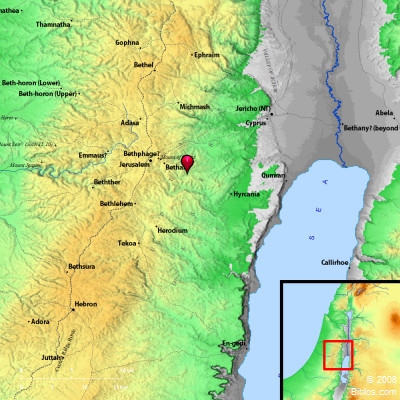Encyclopedia
JUDAEAjoo-de'-a, ju-de'-a (Ioudaia): The "land of the Jews," the Greco-Roman equivalent of Judah. As most of the Israelites returning from the captivity belonged to the tribe of Judah, they came to be called Jews and their land Judea. In Tobit 1:18 the name is applied to the old kingdom of Judah. For a general description of the physical geography and early history of this region see JUDAH. The limits of this district varied greatly, extending as the Jewish population increased, but in many periods with very indefinite boundaries.
Under the Persian empire, Judea (or Judah) was a district administered by a governor who, like Zerubbabel (Haggai 1:14; Haggai 2:2), was probably usually a Jew. Even as late as Judas Maccabeus, Hebron and its surroundings-the very heart of old Judah was under the domination of the Edomites, whom, however, Judas conquered (1 Maccabees 5:65); in the time of his brother Jonathan (145 B.C.), three tetrarchies of Samaria, Aphaerema, Lydda and Ramathaim, were added to Judea (1 Maccabees 10:30, 38; 11:34); in some passages it is referred to at this time as the "land of Judah" (Iouda) (1 Maccabees 10:30, 33, 37). The land was then roughly limited by what may be called the "natural boundaries of Judah" (see JUDAH).
Strabo (xvi.11, 21) extends the name Judea to include practically all Palestine; as does Luke (4:44 m; 23:05; Acts 2:9; Acts 10:37, etc.). In several New Testament references (Matthew 4:25 Mark 1:5; Mark 3:7 Luke 5:17 John 3:22 Acts 1:8), Judea is contrasted with its capital Jerusalem. The country bordering on the shores of the Dead Sea for some miles inland was known as the Wilderness of Judea (see JUDAH; JESHIMON) (Matthew 3:1), or "the wilderness" (Mark 1:4 Luke 3:2); here John the Baptist appeared as a preacher. According to Matthew 19:1 (but compare Mark 10:1, where the Revised Version (British and American) has "Judaea and beyond Jordan"), some cities beyond Jordan belonged to Judea. That this was an actual fact we know from Ptolemy (v.16, 9) and Josephus (Ant., XII, iv, 11).
According to Josephus (BJ, III, iii, 5), Judea extended from Anuath-Borkaeos (i.e. Khan Berkit near Khan es Saweh, close to the most northerly frontier of Judah as described in JUDAH (which see)) to the village Jordan, possibly Tell `Arad, near Arabia in the South. Its breadth was from Joppa in the West to Jordan in the East. The seacoast also as far north as Ptolemais (`Akka), except Jamnia, Joppa and (according to the Talm) Caesarea, belonged to this province.
After the death of Herod the Great, Archelaus received Judea, Samaria and Idumea as his ethnarchy, but on his deposition Judea was absorbed into the Roman province of Syria, the procurator of which lived at Caesarea.
Of later history it is only necessary to notice that in the 5th century Judea became part of the land known as Palaestina Prima; that at the time of the Latin kingdom of Jerusalem (12th century) all the hill country of Judah from Sinjil to Tekoa was the royal domain, while the southern section to Beersheba belonged to the Seigneur de Abraham (i.e. of Hebron); and lastly that a district, the rough equivalent of the kingdom of Judah, though larger, and of the Judea described by Josephus (BJ, III, iii, 5), though slightly smaller, forms today the Mutaserraflic of el Kuds, an administrative area where more than in any spot in the world the problem of the "land of the Jews" is today increasingly acute.
E. W. G. Masterman




